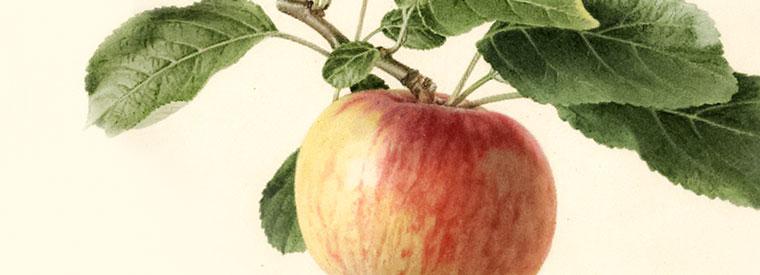Stay me with flagons; comfort me with apples.

Fruit
RIBSTON PIPPIN has the synonyms Essex Pippin, Beautiful Pippin, Formosa, Glory of York, Ribstone, Rockhill's Russet and Travers. It originated in Yorkshire, England, around 1700 as a dessert apple, and was grown from three apple pips (seeds) sent from Normandy to Sir Henry Goodricke of Ribston Hall at Knaresborough, in Yorkshire, in 1709. Only one seed germinated and matured. The original tree was blown down in 1810, but was propped up and lived until 1928. A seed of one of its progeny produced the Cox's Orange Pippin. The apple skin is a yellow, flushed orange, and streaked red with russet at the base and apex. The yellow flesh is firm, fine-grained, and sweet. Some tasters detect a "pear-drop" flavor, and others have compared it to fermenting cider. Irregularly shaped and sometimes lopsided, the apple is usually round to conical in shape and flattened at the base with distinct ribbing. Weather conditions during ripening cause a marbling or water coring of the flesh, and in very hot weather, the fruit will ripen prematurely. It is very slow to begin bearing, and the proper pollinators will increase the fruitfulness. Lord Lambourne has been recommended for a pollinator, as well as Adam's Pearmain and Egremont Russet. It does not need thinning; and good culture, especially attention to the soil condition, is necessary to produce good crops. Ribston Pippin has one of the highest vitamin C contents; 30.30mg/100mg. A vigorous tree with upright growth, its medium-sized ovate to oval shaped leaves are a deep green color and distinctly folded with sharp, regular and shallow serrations. The surface of the leaf is smooth and dull with a heavy pubescence. Ribston Pippin does not store well and ripens in September.
Ripening Period
- Early Fall - September
Other Features
- Pollen Sterile


